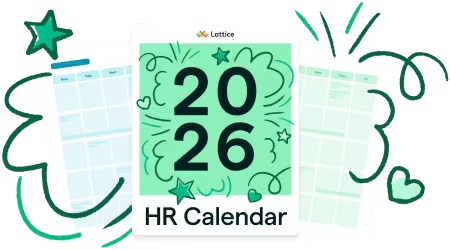Cahill wanted every employee to feel the same level of support and opportunity, whether on a job site or in the office. Lattice gave them a consistent way to gather feedback and develop talent across the entire workforce.
If people are good, we want to keep them. We use Lattice surveys, regular meetings, and Lattice one-on-ones to know what people’s goals are and help them to develop. If you’re a carpenter today, do you want to be a superintendent? What skills and skills-based training would you need?

If you’re working on construction projects, change is the only constant. With a frequently rotating workforce, it can be particularly tough to build a true connection between your people and your company.
This was the challenge for Cahill Contractors LLC, a majority family- and woman-owned general contractor in the Bay Area. With seasonal work and frequently changing project teams, Cahill has an uphill battle creating a seamless employee experience for their 250 office-based staff and on-site laborers, carpenters, and engineers.
We spoke to Senior HR Manager Megan Lamberti and HR Coordinator Jordyn Obey about how their small HR team has created a welcoming workplace to be proud of, regardless of how often their workforce changes.
Here are the five lessons they’ve learned about giving their office-based and on-site staff the support and consistent employee experience they need:
1. Establish good connections right from onboarding.
Great onboarding is vital for making new hires feel at home and part of the company culture right from day one. Lattice research shows that employees thrive when they have a clear understanding of their role and how they fit into the organization — and onboarding is the best way to create that clarity for new hires.
So that’s where Cahill’s HR team focused their attention first. “In the past, new project staff would just get sent to the job site after day one,” remembers Jordyn. “They often didn't know how to use the programs. Our operations team created a next-day training program, tailored to the individual level, to get them up to speed with the Cahill way.”
The little things can also make a big difference. Reaching out to say welcome to new hires and communicate details — like where to park, which entrance to use, and where to meet — helps new employees feel a part of the company.
“It’s such a simple thing to do, to send a LinkedIn message saying, ‘We're so happy you're doing this.’ And it takes two seconds to do that.”
Megan and Jordyn have been able to track the results of their improved onboarding program with Lattice. Their onboarding survey shows that 92% of new hires found the onboarding enjoyable and valuable.
2. Support your teams with continual performance management.
For businesses with project-based teams, changing managers every two years or so can be disruptive. This makes it important to have a strong structure for ongoing performance reviews.
“People often have to move project to project,” says Megan, “so it's important to have some continuity, so they're not starting from square one with a new manager.”
They’ve used Lattice to centralize performance information, so each new manager has all the history of the employee at hand. “It’s been great to see past performance reviews and feedback — not just people's opinions.”
Throughout the year, Cahill employees review their goals, make edits, and have regular one-on-ones with their managers. Every summer, the HR team conducts 360 reviews, which include self-reviews, peer reviews, manager reviews, and upward reviews of employees’ managers.
The HR team also added a 90-day post onboarding survey. With a big post-onboarding gap until the six-month check-in, getting feedback at 90 days meant managers could assess how new hires were settling in and progressing with their goals and could make adjustments.
With Lattice, these reviews can be scheduled automatically. As an employee approaches the one-month, 90-day, or 6-month mark, they and their manager receive an email notification, taking the pressure off the small HR team.
3. Help your managers be more effective.
“Initially, we had a very low score in manager support,” admits Megan. “Employees weren't feeling supported by their managers, and we weren't really good at providing the tools for managers to succeed in a position of responsibility.”
Cahill’s HR team put in place manager training on how to interact effectively with employees, manage their goals, and approach situations like giving constructive feedback effectively. Megan then meets quarterly with the C-suite to look through the pulse feedback by department or manager and identify trends to get ahead of.
As a result of the added focus on manager training and support, manager support increased 34% year over year according to Cahill's employee survey.
What’s more, the leadership team makes the point of connecting with the on-site staff.
“Our president makes an effort to go to job sites regularly, showing he’s not just a person in the office, but instead is interested in how they are doing.”
Lattice also proved helpful in improving manager effectiveness. With insights from employee surveys and 360 performance reviews, managers of managers can assess areas for improvement and target training and coaching to areas where managers need more support.
Templates within Lattice make sure that Cahill’s managers cover everything they need to.
4. Improve your internal mobility.
With a shortage of field labor, it’s wise to cultivate your people and keep them onboard. Cahill aims to offer long-term employment and progression, finding what people want to do and supporting them to achieve it.
“If people are good, we want to keep them. We use surveys, regular meetings, and one-on-ones to know what people’s goals are and help them to develop. If you’re a carpenter today, do you want to be a superintendent? What skills and skills-based training would you need?”
In this way, Cahill makes a point of trying to right-size employees in the business. This is often self-driven, with employees positioning themselves to fill a skills gap.
“If someone’s a good culture-add and lives and breathes our values, we try to find a space in another department, if they have physical skills and are interested in it,” says Megan.
And the numbers bear this out with Cahill seeing 23 field promotions and 22 office promotions in less than two years.
4.Make sure your employees are happy.
Investing in employee engagement is a win for your business as well as your people. Cahill’s HR team uses Pulse surveys in Lattice to gauge employee satisfaction and engagement. Every two weeks, employees get three different questions to respond to, drawn from a library of questions, and tailored to key themes.
The question “I'm proud of the work that I do” consistently gets a score of 90.
“We've learned that people see how what they do impacts the company and the city,” says Megan. “There’s a very tangible outcome for what they're doing. Even if they don't like their job right now, they can see how they’re making a difference.”
Megan credits Lattice's 1:1 feature for making it easier for managers and employees to get aligned on career goals and remove obstacles in daily work.
How Lattice Helps Support HR Teams and Managers
Successful HR teams know how to connect their work to business outcomes — and get the support they need from C-suite. They’re also 2.6 times as likely to be using performance management software.
Megan and Jordyn say that Lattice’s people management platform has helped them streamline Cahill’s HR support, bringing one-on-ones, feedback, goals, and reviews together in one unified space.
What’s more, with a diverse and dispersed workforce, Lattice has made it easy for staff at all levels to engage with and manage their HR and performance management needs.
“We’re a construction company, and people have different comfort levels with technology,” Megan points out. “Lattice’s UI is really attractive and very easy to use. It's very straightforward, especially for people who are not as technologically savvy. It's been a big win for the company.”
For a company like Cahill, which is always looking for ways to make continuous improvements to their employee experience, Lattice offers that kind of cohesion to bring together two very different workforces under one platform.
To see how Lattice can streamline your performance management, request a demo.





%20(1).jpg)

